Dodge Promaster vs Mercedes Sprinter vs Ford Transit: What’s the Best Van? - Van Conversion Comparison Guide
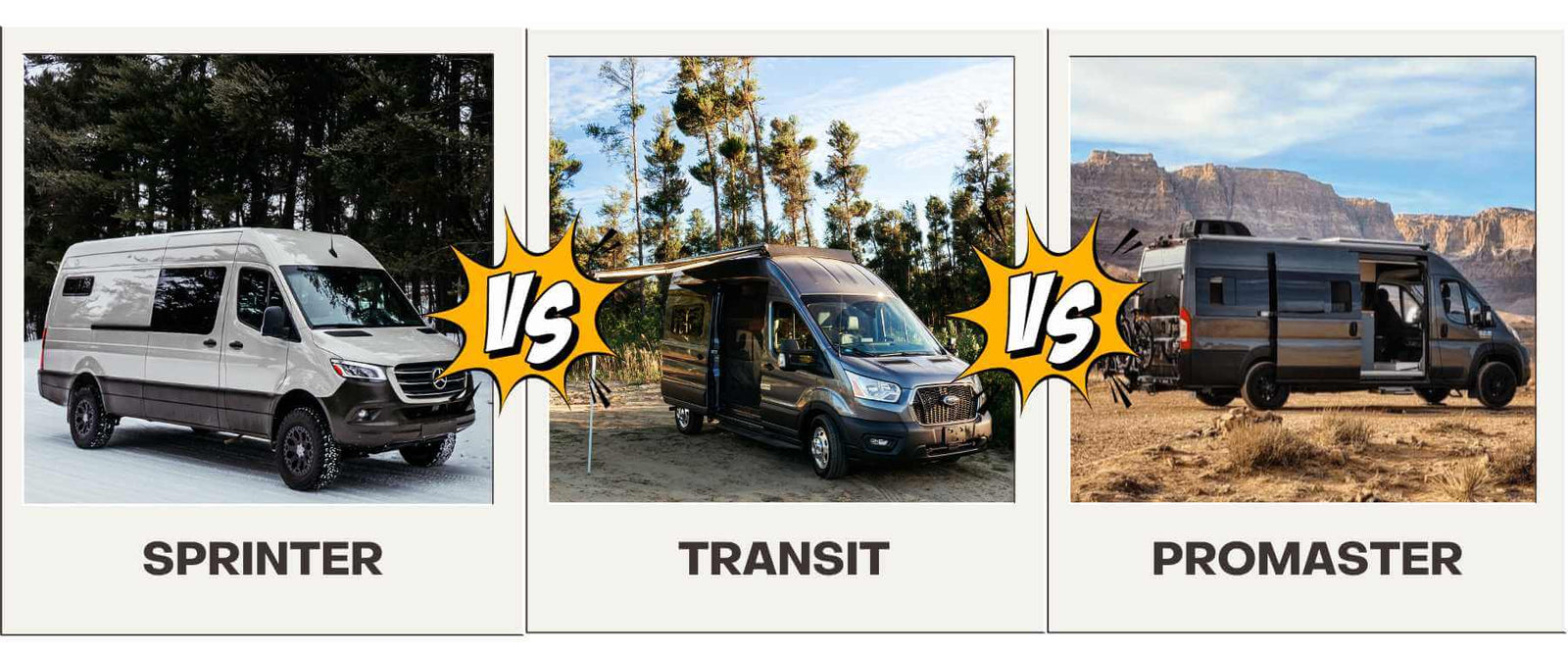
Welcome to our ultimate guide comparing the top contenders in the van conversion world - the Mercedes Sprinter, Ford Transit, and Ram Promaster. These large vans are known for their roomy interiors, massive cargo capacity, and heavy duty use or conversions. Sure there are other vans but these are the best of the best when it comes to camper vans.
Whether you’re a seasoned van lifer or just looking to dip your toes into the van life, our detailed comparison will help you make an informed decision. We’ve used our experience and insights from industry professionals to bring you a head to head comparison of these popular camper vans.
Remember choosing the right van is the first step in your bespoke van conversion. So buckle up as we get into the nitty gritty of each van model and help you in your search for the perfect van life. Make sure to keep reading our blog for more van conversion DIY, professional conversion companies and more.
Our mission is to provide you with the best resources to help you start your van life journey.
Enough chit chat, Let’s d(r)ive in.
Here's your crash course template on purchasing a conversion van:
- Overview of the Mercedes Benz Sprinter
- Pros and Cons of a Mercedes Sprinter van conversion
- Overview of the Ford Transit
- Pros and Cons of a Ford Transit van conversion
- Overview of the Dodge Ram Promaster
- Pros and cons of a Dodge Promaster van conversion
- A recap comparison between the three main conversion vans
- 2WD VS 4X4 VS AWD van conversions
- Gas vs Diesel van conversions
- Campervan towing capabilites
- Important questions to ask yourself
Want more great advice & content delivered to you weekly?
Join our free weekly newsletter! You'll receive weekly video blogs with more actionable advice, tricks, and behind the scenes work that happens in our custom van conversion shop!
What’s the best van chassis to convert a van conversion?
Mercedes Sprinter Van Conversion Overview
Oh yes, the custom sprinter van conversion! The Mercedes Benz Sprinter van is a popular choice for van conversion enthusiasts, mainly because of its performance, comfort and customization options. Inside the Sprinter has a user friendly dashboard and controls so you can easily access everything. The adjustable driving position means optimal ergonomics and comfort, especially on long trips. The ride quality of the Sprinter stands out, offering a comfortable experience with low noise levels and stable handling, making it suitable for both daily driving and extended conversions. Known for its solid build quality and reliability the Sprinter van is great for city driving and off road adventures.
Sprinters are roomy
One of the best features of a Sprinter van is its roomy interior with its longer wheelbase options which can be customized to fit your needs. This makes it perfect for full time van life as it can fit a fully equipped kitchen, a comfortable bed and even a compact bathroom. Sprinters have the largest interior cargo space so you have plenty of room for extra amenities and activities when designing your custom camper van layout. However due to the van's width installing a sideways bed can be tricky without modifications as the interior is too narrow for this configuration. The 170” wheelbase can fit a family of 4 and most of the amenities you’d need in an adventure vehicle with room to spare. There’s plenty of standing height in the Sprinter as well especially if you opt for the super high roof which increases interior clearance and makes it easier to stand and move around.
Compared to the Sprinter, fwd models like the Promaster typically have lower floors and more interior height, which can be advantageous for certain camper conversions.
We break down the dimensions below.
Mercedes is expensive
But popularity comes with a price. The Mercedes Benz Sprinter van is often more expensive upfront compared to other van options and is known for high maintenance costs. The higher upfront cost combined with the high maintenance costs is something to consider especially for those on a tight budget. Additionally maintaining a Sprinter can be more complicated due to its advanced engineering. So finding a mechanic familiar with Mercedes vehicles might be necessary which could add to the maintenance costs. According to annual fleet news industry surveys and reports, the Sprinter consistently ranks high for reliability among vans used by leasing companies and fleet operators, which can help offset some concerns about long-term maintenance. Some buyers may prefer cheaper alternatives like the Ford Transit or Ram Promaster which have lower purchase prices and lower upkeep costs.
Choosing a Mercedes Sprinter van for your custom conversion requires careful consideration of these factors. But for many the benefits of a spacious, comfortable and high performing van outweigh the extra costs making it a popular choice in the van life community.
The Sprinter van arguably has the best looking exterior for a stock cargo van and most options for aftermarket parts from companies like Aluminess which specializes in van conversion accessories.
Overall the Sprinter van conversion is the most popular option for most van lifers and for good reason. We’ve converted them before and continue to do so!

Sprinter Van conversion PROS:
- Until Ford came out with the AWD Transit van in 2020 the Sprinter Van was the only van with a factory 4x4 or AWD option.
- Sprinters hold their value extremely well for resale value.
- Sprinters offer powerful engines with high horsepower and torque, making them ideal for towing, climbing hills, and carrying heavy loads.
- Diesel gives you the option for a Webasto or Espar heating system. without building an auxiliary diesel tank.
- NOTE: There are now Petrol/Gas air heater systems that make this a pro for all van models, regardless of fuel type.* Better MPG in the 6-cyl diesel.
- More availability in aftermarket van parts like roof racks, ladders, tire carriers, bumpers and more.
- Sprinters are known for their longevity so you can go further for longer in your van conversion.
Sprinter Van conversion CONS:
-
On the flip side, a Mercedes vehicle comes with a higher upfront cost and maintenance fees. If anything happens with the electrical systems it’s going to cost a lot more than if you owned a vehicle from Dodge or Ford. Even oil changes are more (however they last longer).
-
When it comes to service there are far fewer Mercedes dealerships than a Fiat Chrysler Dodge or a Ford shops. In saying that this is not taking into account any specialized import vehicle mechanics. However from experience the rates at shops like this are often more expensive. It’s also important to follow the manufacturer-recommended services and scheduled upkeep to maintain your warranty coverage and ensure reliable operation.
- Mercedes dealerships (21 in Canada, 370 in the USA).
- Ford dealerships (440 in Canada, 2500 in the USA).
- Dodge dealerships (400+ in Canada, 3000 in the USA).
-
If you opt for a diesel sprinter van conversion you need to think about where you’ll be travelling. It’s harder to travel to more southern countries where diesel and low-sulphur fuel are less-available. With that the quality that is available isn’t what Mercedes recommends for use in their vehicles.
- New Mercedes Sprinter vans (2025+) are only available in Diesel.
- The dreaded DEF debate. You can read more on this here.
Mercedes sprinter van interior dimensions



Credit: Upfit supply
The generous interior dimensions of the Sprinter not only provide ample space for conversions but also play a crucial role in determining the van’s payload capacity, ensuring you can carry both your build and your gear safely.
Mercedes sprinter van exterior dimensions

Credit: FVCO
The Mercedes Sprinter is available in several configurations with two different wheelbase and three overall length options. The 170 wheelbase extended length has the most cargo space and interior height, perfect for larger camper conversions or hauling big loads. The 170 wheelbase regular length is a balance between interior space and overall length, good for both commercial and camper use. The shorter wheelbase is more maneuverable and better suited for urban driving, tight spaces and smaller loads.
With the 170 and 170 EXT, you need to be careful with the additional length. You will be tempted to fill it up with tons of extra cabinetry but the payload does not increase with the length. It becomes a delicate balance of additional space without additional weight allowance. Planning your build is extremely important to ensure you are not overweight.
Sprinter van overview summary
In summary the Mercedes Sprinter is one of the top choices for van conversion enthusiasts due to its great handling, spacious interior and many customization options. This summary gives you a clear picture of the Sprinter’s pros and cons to help you make an informed decision. Although it’s more expensive upfront and potentially more maintenance fees the Sprinter’s benefits often outweigh the drawbacks for many in the van life community. The Sprinter holds its value, is long lasting and has many aftermarket parts available making it a great choice. However you should consider factors like travel plans, service centers, cost of ownership and fuel type before deciding on a Mercedes Sprinter van conversion.
Ford Transit Van Conversion Overview

You’re probably wondering… I thought Ford made cargo vans that were shorter and boxier. You’re right. They make the E series vans also known as the Ford Econoline, those little panel vans that tradesmen drive. Well campers have upgraded from those gas-guzzling, turning like a tank, short vans that you needed a pop-top campervan or roof cap with these beautiful Ford Transit cargo vans.
The latest models of the Ford Transit feature updated technology, including digital dashboards and advanced driver aids, offering significant improvements over older versions.
When considering alternatives the VW Transporter is a popular smaller van option that is imported from the United Kingdom. While the VW Transporter is great to drive and is often chosen for camper conversions it may not be as suitable for larger load requirements compared to the Transit or Sprinter.
Did you know Ford just released a new 2023 Ford Transit Trail directed right at people like you and me who are looking for a van conversion?
It’s pretty cool, check out our blog post on it here.Ford Transit van conversion is getting popular with van lifers especially since 2020 when they released the AWD cargo van to rival the 4x4 Sprinter van. With the popularity growing so does the aftermarket parts. Companies like Aluminuss, Flat Line Van Co, Backwoods Adventure Mods and more are making amazing aftermarket Ford Transit van conversion parts.
Ford Transits are affordable luxury
We love that Ford Transits are way more affordable than the Mercedes Sprinters and still have an ‘intelligent AWD’ option for those tougher terrains like we have up here in Canadian winters. However when comparing base prices the Promaster is usually the cheapest option, lower initial cost and lower maintenance costs. Fords can be fixed anywhere at any mechanic unlike import cars especially Sprinters.
The biggest knock on the Transits which will be fixed over time is that there are no used ones because it’s so new. They’ve only been manufactured since 2014. And of course the never ending Dodge vs Ford debate in the truck community which of course boils into the van conversion community which brings Mercedes into the mix.
With Ford offering an AWD model and easier to get service more and more of our clients are switching their decision from Sprinter van conversion to Ford Transit conversions.
Although the AWD option is attractive the affordability upfront, lower maintenance costs, mechanic availability and the eco-boost engine have the Ford Transit throwing a pretty heavy counter punch at the Sprinter Vans for first place.
Example: Check out our most recent Ford Transit Van Conversion here.

Smaller but growing aftermarket upgrade segment
When comparing Transits to Sprinters one noticeable drawback is the limited options for interior and exterior colors and materials. Sprinters have more customization options while Transits lag behind. However it’s worth noting that there is still a market for aftermarket accessories including Transit roof racks to personalize your van.
Used AWD Ford Transits are hard to find
Used AWD Transits are also harder to come by. Ford only introduced the AWD option in 2020, a feature Sprinter has had for many years (4x4 but now AWD). If you’re looking for a used AWD Transit it may take a bit more searching and patience.
Sprinter vs Transit Considerations
Another consideration is clearance. Transits have less clearance than Sprinters. If you plan to take your van off the beaten path this is something to consider.
Finally, note that Transits are less fuel efficient than Sprinters. Sprinters are known for their great fuel economy and Transits don’t quite match that even with the Ecoboost. If fuel efficiency is a big deal for you and you don’t mind going diesel then this is something to keep in mind.
Ford Transit Van Conversion Pros:
-
Ford Transits have the tallest roofs available in a factory van. So if you’re tall this may be a no brainer for your van conversion. Even if you’re not tall that little extra space might make a big difference to you!
-
The Eco-boost engine is awesome, they have a lot of power and are great on fuel getting similar MPG to the 6-cylinder diesel Sprinter.
-
As of 2020 Ford has an AWD option so you’re no longer limited to the Sprinter van for 4x4/AWD van conversion options.
-
Availability of service. Plenty of dealerships and mechanic shops can work on these vans and they are cheap to have work done on.
-
The new Ford Transit Trail is geared towards custom camper van conversions. It has quite a few options for van builders and custom vans in general, saving the consumer from adding aftermarket suspension and side steps for example.
-
Adjustable driving position for comfort, with seats and steering wheel designed for ergonomics during long drives.
Ford Transit Van Conversion Cons:
On the other hand with the long body van chassis they have a long rear end overhang (shortest wheelbase in the longer options between the three competitors) so the rear end can scrape coming out of driveways or be a hindrance when going off the beaten path. It’s highly recommended to get a levelling kit or suspension upgrade.
The wheel wells are small so adding aftermarket van conversion accessories and wheels is more challenging but doable.

Ford Transit wheelbase options:
The three different wheelbase options for the Ford Transit van are:
- 130" wheelbase with a Mid Roof
- 148" wheelbase with a High Roof
- 148" extended wheelbase with a High Roof
While the 148” wheelbase models are the smallest 'larger' wheelbase option in the three vans and provide good interior space and maneuverability, there is also a shorter wheelbase option available on some Transit models. The shorter 130" wheelbase is more for urban driving or when you need to handle tight spaces and is rarely seen in campervan conversions.
We stick to the 148 wheelbases, both regular and extended length, for all of our Ford Transit conversions. It gives us plenty of room to fit everything you need for 2 full-time adventurers with some space to spare. However, we have also done Ford transit van conversions to seat and sleep 4!
Ford Transit interior dimensions

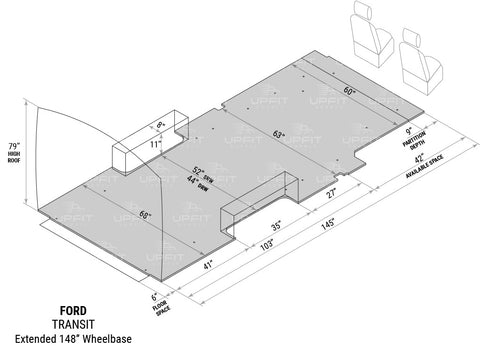
Credit: Upfit Supply
Ford Transit exterior dimensions

Credit: FVCO
Ford Transit summary
The Ford Transit van has emerged as an attractive and viable option for camper conversions, providing a budget-friendly alternative to the popular Mercedes Sprinter. Notable for its tall roof, robust Eco-boost engine, and 'intelligent AWD' feature suited for tough terrains, the Transit is increasingly favoured by outdoor enthusiasts and van lifers. Though it may not offer as much customization as the Sprinter and the availability of used AWD models is relatively low, its affordability, accessible maintenance, and efficient fuel consumption make it a strong contender. Worth mentioning is the new Ford Transit Trail edition, designed specifically with camper conversions in mind.
However, potential challenges include a long rear-end overhang with the long body chassis and smaller wheel wells, which may complicate the addition of aftermarket conversion accessories.
Dodge Ram Promaster Van Conversion Overview

Yes, the Dodge Sprinter was a thing. Now it’s the Mercedes Sprinter and the Dodge Ram Promaster. Confusing right?
Well these vans are not alike. In fact they have quite a few differences. Like the Ford Transit, Promaster vans are much more affordable than the Sprinter van. The Ram Promaster is the most affordable van you can buy for your camper van conversion. The Promaster shares its platform with the Fiat Ducato, which is also popular among DIY camper builders for its large interior space, cost advantage, and suitability for camper conversions. Unlike some competitors that are considered a heavier vehicle, the Promaster is lighter which makes it easier to handle and more comfortable to drive for many van users. So if you’re a budget conscious van DIYer this should be a no brainer choice.
Ram Promasters are the most budget friendly campervan
The big attraction to the Ram Promaster, besides being the most affordable, is that it’s the widest van chassis, so you can install a sideways bed and sleep sideways without adding flares (depending on your height). This layout option is not feasible in narrower vans like the Sprinter or Crafter due to their width or interior design constraints.
Our clients love the fact that Dodge, along with Ford, are much more affordable and easier to maintain compared to the Mercedes Sprinters. The width and straight walls are additional bonuses.
Promasters have FWD but no 4x4 or AWD
The biggest problem with the Promaster van conversion, for most, is that there’s no option for 4x4 or AWD. I’ve talked to a couple 4x4 conversion companies and you cannot even convert these into a 4x4 van conversion, even if you wanted to, because of the way the chassis is built. Additionally the Promaster does not offer rear wheel drive or twin rear wheels configurations which are available in some competitors and can provide increased load capacity and towing performance. But if you’re okay with a 2WD campervan the Promaster has FWD which is better than RWD.

Dodge Promaster Van Conversion Pros:
- Promaster vans are the widest available cargo van, which makes side-to-side bedding a breeze - depending on your height you may not even need to add flares from Flarespace.
- The turning radius on these vans is amazing for a cargo vehicle. Depending on what your intended use is, this may be beneficial for manoeuvring back roads and bushwacking. This is even noticeable in daily driving and super nice to have.
- Plenty of dealerships and mechanic shops can work on these vans and they are cheap to have work done on.
Dodge Promaster Van Conversion Cons:
- There is no way to do an AWD or 4x4 conversion on the current Dodge Promaster models.
- Less aftermarket accessories.
- With no diesel option and a lower amount of power overall, these vans are not good for towing.
- Overall, these vans have the smallest length for a van conversion at 140" in the interior. If you plan on having a lot of accessories or full-time living in this unit with multiple people, this van might not be for you.
Ram Promaster wheelbase options:
The Dodge Promaster comes in a few different wheelbase options. The different Promaster options are:
- Promaster High Roof 136”
- Promaster High Roof 159”
- Promaster High Roof 159” Extended
Dodge Promaster interior dimensions


Credit: Upfit Supply
Dodge Promaster exterior dimensions

Credit FVCO
Ram Promaster summary
In the realm of campervan conversions, the Ram Promaster presents itself as an appealing choice, particularly for budget-conscious DIYers. Its main allure is its status as the most affordable option among its peers, the Ford Transit and the Mercedes Sprinter. Beyond affordability, the Promaster's standout feature is its wide chassis. This unique attribute allows for easy side-to-side bedding arrangements, potentially eliminating the need for additional flares. The vehicle's superior turning radius, wealth of mechanic shops capable of servicing it, and low maintenance costs are advantageous. However, it possesses notable drawbacks.
The absence of AWD or 4x4 conversion options, a lesser range of aftermarket accessories, lower power for towing, and the smallest interior length among the three make it less versatile than the Ford Transit and Mercedes Sprinter. Hence, while the Promaster shines in affordability and width, potential van-lifers must consider the trade-offs in power, customization, and interior space.
Example: Check out our most recent Promaster van conversion here.
Want more great advice & content delivered to you weekly?
Join our free weekly newsletter! You'll receive weekly video blogs with more actionable advice, tricks, and behind the scenes work that happens in our custom van conversion shop!
Sprinter vs. Transit vs. Promaster - Campervan cost comparison
Price is indeed a crucial factor for most people considering a van conversion. While each van - Sprinter, Transit, and Promaster - has its unique advantages and disadvantages, their cost differences are significant and worth considering.
Additionally, more often than not, camper van conversion companies will only work with Sprinter vans. So, before you purchase anything, talk to the van conversion company you plan to work with and see what Chassis the work on!
Sprinter Van Conversion Pricing - Most Expensive
Mercedes Sprinter is undeniably the most expensive among the three options. The 2025 Mercedes Sprinter 2500 with 144-inch wheelbase starts at around $70,000 CAD before taxes. Sprinters are popular for their reliability, resale value and interior space. Mercedes commands premium pricing but offers sophisticated engineering and durability for long term adventures.
As soon as you add AWD to your Sprinter (2023 and newer), the price increases by roughly $13,000 Canadian, or $10,000 USD. The high cost, easily crossing $75,000 USD or $100,000 Canadian with additional chassis features, is justified by its robust build, excellent driving experience, and premium brand name. However, the maintenance and repair costs can also be considerably higher than the other two options.
Ford Transit Van Conversion Pricing - Mid-Range
Ford Transit vans present a more affordable option when you consider the AWD or Trail packages. The 2024 148-inch high roof AWD model starts at around $65,000 CAD. Transits have good interior space and reliable performance at a more affordable price point. The Ford dealer network across Canada means maintenance and service is convenient during your travels. Its affordability doesn't compromise on quality, with many features geared towards van builders, like the Sprinter.
The Ford Transit Trail, a new addition to the Transit lineup and only available in the United States as of updating this article, is specifically designed with completely custom van builds in mind. It offers numerous features that make it an ideal base for a camper van conversion, like a 3.5" lift kit, wider track width, black alloy wheels, all-terrain tires, skid plates, side nerf bars, and much more. With a solid start to exterior accessories, they leave you to finish the custom interior. A T250 148" Regular Length Ford Transit Trail starts at $68,000 USD.
The maintenance costs are also relatively lower, making it a cost-effective choice for many.
Ram Promaster Van Conversion Pricing - Budget-Friendly
The 2024 RAM Promaster 2500 159-inch extended model starts near $63,000 CAD, the most affordable new van option. Promasters have the most interior space and lowest floor height, ideal for taller individuals or those who prioritize interior volume over off road capability. It is the most budget-friendly option, toted by some to be the perfect van for DIYers. However, keep in mind that there might be fewer customization options, and it doesn't offer a 4x4 or AWD option.
Price Recap
In terms of a cost comparison, the three conversion vans - Sprinter, Transit, and Promaster - present a range of options catering to varied budget brackets. At the high end, the Mercedes Sprinter offers premier features and performance, but it comes with a higher purchase and maintenance cost. The Ford Transit, priced at provides a balance of affordability and quality features, making it an attractive mid-range option. Lastly, for those operating on a tighter budget or seeking a base for DIY projects, the Ram Promaster offers the lowest initial investment, despite having fewer customization options and lacking a 4x4 or AWD option.
Additionally, it is essential to consider the specific needs, requirements, and budget constraints before making a decision. Each of these vans has a distinct set of features that cater to different needs, and finding the right balance between cost and functionality is key.
Used vans offer big savings for budget-conscious buyers. 2018-2021 Sprinters range from $45,000 to $65,000 CAD, depending on mileage and condition. Inspect carefully when buying used as conversion costs can quickly add up if major repairs are needed. Vintage ambulances and box trucks offer unique conversion opportunities for $15,000 to $35,000 CAD. These vehicles require more work but have large interior volumes and interesting starting points for creative builders willing to tackle unique challenges.
Lastly, remember these prices are only for the base van and do not include the cost of custom builds or additional options on the vehicle itself, like the Trail package, or RV prep package, which will make life easier on you and your camper van conversion company. Each custom build will depend on what the van conversion company offers for custom designs. The build process and van specialties are different with each custom upfitter. It's critical to chat with several builders and know what you're looking for in your builder and you send a deposit to a camper van conversion company.
Read our blog on what to look for in a camper van conversion company for some tips.
Sprinter vs. Transit vs. Promaster - Fuel & Mechanical Comparison
|
|
Engine |
MPG |
Transmission |
HP |
Torque |
|
Sprinter |
6 Cyl 3.0L Diesel |
20 |
7 Speed Auto |
188 |
325 |
|
|
4 Cyl 2.0L Gas |
17 |
9 Speed Auto |
188 |
258 |
|
Transit |
Gas 3.5L V6 Eco Boost |
17 |
10 Speed Auto |
306 |
400 |
|
|
3.5L V6 Gas |
17 |
10 Speed Auto |
271 |
260 |
|
|
2.0L Turbo Diesel |
20 |
10 Speed Auto |
210 |
369 |
|
Promaster |
3.6L V6 Gas |
17 |
7 Speed Auto |
280 |
258 |
When it comes to mountain roads, the Sprinter’s diesel engine offers strong torque for climbing steep inclines, while the Transit’s EcoBoost provides responsive power and traction on winding terrain. The Promaster handles mountain roads with decent engine power, but may feel less responsive on tight curves compared to the others.
Why does this mechanical information matter?
- It's nice to look at this chart to compare the vans for your conversion for a few reasons. If you are going to be towing gear or doing a lot of mountain driving, a transmission with more gears and a van with more torque is going to be beneficial.
- An easy way to remember how this works is a quote from Tims Capital Trucking. "Torque does the work, but horsepower makes the work go fast".
- A higher torque will allow you to tow more weight with lower RPMs which in turn results in greater fuel economy.
-
Maintaining control is key, especially when your van is fully loaded. Features like advanced braking systems and driver assistance technologies help you stay in control in all driving conditions. Something like Agile Off-Roads Big Brake kit and RIP Kit is a good add if you are building a heavy rig
Towing comparison
It's nice to look at this chart to compare the vans for your conversion for a few reasons. If you are going to be towing gear or doing a lot of mountain driving, a transmission with more gears and a van with more torque is going to be beneficial.
An easy way to remember how this works is a quote from Tims Capital Trucking. "Torque does the work, but horsepower makes the work go fast".
A higher torque will allow you to tow more weight with lower RPMs which in turn results in greater fuel economy.
When we delve into the towing capabilities of the Sprinter, Transit, and Promaster vans, we uncover another layer of their utility.
The Mercedes Sprinter boasts a substantial towing capacity. The 2WD version can tow up to 5,000 pounds, which is certainly considerable. When configured correctly, the Sprinter offers impressive towing performance despite its luxury status and higher cost.
The Ford Transit, on the other hand, also offers a solid towing capacity. Depending on the model and configuration, it can tow between 4,600 and 7,500 pounds. This makes it a versatile choice for those who anticipate needing to tow heavier loads.
Lastly, the Ram Promaster, despite its budget-friendly price tag, doesn't compromise on towing power. It has a towing capacity of 5,100 pounds, which is slightly more than the Mercedes Sprinter. This makes the Promaster a viable option for those planning DIY conversions who also need stout towing capabilities.
In summary, all three vans - Sprinter, Transit, and Promaster - offer substantial towing capabilities, adding to their appeal as base vehicles for camper van conversions. However, the exact towing capacity can vary depending on the specific model and configuration, so it's important to consider your specific needs when choosing your van.
Fuel Mileage
Sprinter Fuel Mileage
Prior to 2024 the Sprinter came in Diesel and Gas options. Gas had a 4-cylinder and Diesel had a 4 or 6-cylinder. As of 2024 Mercedes has eliminated the Gas Sprinter altogether and only offers the 4-cylinder turbo-diesel.
These vans are known for their great fuel economy, 16-18 mpg city and up to 22 mpg highway. Average is 20 mpg. They are a great option for those who will be doing long road trips or off-grid living. The difference in fuel consumption is generally not very significant for most AWD vehicles.
Transit Fuel Mileage
The Ford Transits are available in Gas and Diesel in their current offerings. They have a 3.5L V6 Ecoboost which is the most popular but they also offer a 2.0L turbo-diesel.
Ford Transit’s fuel economy varies with the engine choice. The popular 3.5L V6 Ecoboost engine which is known for its power delivers 15 mpg city and 19 mpg highway.
The 2.0L Turbo-Diesel has similar fuel economy as the Sprinter. So the choice between the two engines is up to the user’s needs and preferences, power and performance or fuel efficiency.
Promaster Fuel Mileage
As you can see above the Ram Promaster with the 3.6L V6 engine has decent fuel economy considering its size and cargo capacity. It’s noted to get 14-16 miles per gallon (mpg) city and 19-21 mpg highway for an average of 17 mpg. However operators should be aware that towing heavy loads will significantly reduce the vehicle’s mileage as it’s underpowered compared to the other two van options.
But remember actual fuel consumption will depend on specific driving conditions and habits and the weight of the van’s build-out.
Gas vs Diesel camper van
Choosing between a gas or diesel camper van will impact your travel experience and comfort. The type of fuel your vehicle uses will affect your van’s heating options, where you can travel and the overall performance of your van.
Espar, a popular heating system provider, offers both gas and diesel hydronic furnaces, giving van owners flexibility. These furnaces are designed to provide consistent, efficient heating making your camper van comfortable even in cold climates. The choice between a gas and diesel furnace will depend on the fuel type of your van as it’s more efficient to have a furnace that runs on the same fuel.
When considering where you will travel, it’s worth noting that quality diesel can be hard to find below the American border. So if you will be traveling to Central or South America a gas powered van may be the more convenient option.
As for performance we’ve discussed towing and fuel economy above.
In summary the choice between a gas or diesel camper van will depend on your specific needs, preferences and travel plans. Be sure to consider all these factors to make an informed decision that will serve you well on your adventures.
Sprinter vs. Transit vs. Promaster - Warranty, Service & Cost of Ownership
When it comes to warranties and service coverage each van has its own set of offerings.
Mercedes Sprinter
The Mercedes Sprinter has a limited warranty that covers the vehicle for 3 years or 36,000 miles, whichever comes first. They also offer a drivetrain warranty for up to 5 years or 100,000 miles. Maintenance costs for Mercedes vehicles are higher. Over 5 years it’s estimated to cost between $3,000 - $5,000 USD. To keep the warranty valid regular services are required as per the manufacturer’s recommendations. Mercedes holds its value for longer periods of time than the competitive brands.
Ford Transit
The Ford Transit has a basic warranty for 3 years or 36,000 miles and 5 years or 100,000 miles for its diesel engine. When it comes to maintenance the Transit is less expensive than the Sprinter. Over 5 years it’s estimated to cost between $2,500 - $4,000 USD. The Transit can be serviced at a wide network of dealerships making routine services and repairs convenient and accessible.
Ram Promaster
The Ram Promaster like its competitors has a basic warranty of 3 years or 36,000 miles. The Promaster’s maintenance costs are low like the Transit with an estimated 5 year cost of $2,000 - $3,500 USD. Regular services are also necessary to maintain warranty coverage.
For those seeking alternatives, especially imported, the Iveco Daily stands out as a heavy-duty, truck-like van with a rugged build, making it ideal for demanding applications such as towing, large payloads, and heavy conversions. The Renault Master is often chosen for its reliability, cost-effectiveness, and practical dimensions, making it a solid and durable platform for conversions or commercial use, especially for budget-conscious buyers. The MAN TGE is closely related to the VW Crafter, offering a budget-friendly alternative with similar specifications, but differences in service networks and pricing—often providing better deals through fleet offers.
In summary while each van has competitive warranties the overall maintenance costs may play a big role in long term ownership. All three vans can be serviced at a wide network of dealerships for each brand across the US and Canada so accessibility to service centers should not be an issue for any of the three vans.
-
Mercedes dealerships (21 in Canada, 370 in the USA).
-
Ford dealerships (440 in Canada, 2500 in the USA).
-
Dodge dealerships (400+ in Canada, 3000 in the USA).
Recap of the best van for van conversions:
Mercedes Sprinter van conversions:
-
The current Sprinter has the longest available wheelbase and interior length available, making it a great starting point if you need extra space. The current Sprinter also has updated technology and design improvements over previous models.
-
AWD option.
-
Lots of aftermarket accessories.* All camper van conversion companies work on Sprinters.
-
Most expensive van from the factory but holds its value.
-
More expensive maintenance and fewer dealerships for servicing.
-
The Volkswagen Crafter is a comparable alternative in the large van market, known for its versatility, technical features and suitability for various commercial and conversion purposes.
Ford Transit van conversions:
-
Highest van interior.
-
AWD option after 2020, including the notable Transit AWD introduced in 2020.
-
Mid-range price.
-
Lots of camper van conversion companies work on Transits.
-
Lots of aftermarket accessories.
-
Some people don’t like their eco-boost engines.
Dodge Ram Promaster van conversions:
-
Widest van interior.
-
Most affordable van conversion chassis.
-
Easiest DIY camper van
-
No factory 4x4 or AWD option and at the moment it’s not possible to do an aftermarket 4x4 conversion.
-
FWD which isn’t as beneficial as it sounds - most of your weight will be in the back in your campervan.
-
Not the most aesthetically pleasing cargo van until you put aftermarket accessories on it.
-
Fewer camper van conversion companies work on Promasters.
Before you buy a camper van.
What’s my van conversion budget?
Your budget is a big factor when building a campervan conversion. Mercedes Sprinter, Ford Transit and Ram Promaster each fall into different price categories so there’s something for everyone.
Mercedes Sprinter conversions are on the higher end of the spectrum. Its price reflects its premium build quality, extended customization options, better performance, longest van for conversions and strong resale value. But it’s more expensive to buy and potentially more maintenance.
Ford Transit is the middle ground in terms of price. It’s more affordable than the Sprinter, has good fuel efficiency, easier to drive and park and decent customization. But limited storage space compared to others.
Ram Promaster is the most affordable of the three, making it a great option for budget conscious van converters. It has a lot of cargo space, lower maintenance costs and better handling due to its front-wheel drive. But limited customization options, no AWD and may not be as comfortable as the others.In summary each of these vans has its pros and cons. Your budget can play a big role in which one is best for you. So you need to consider not just the initial cost but also the long term costs and benefits of each van.
How much does a van conversion cost? What’s your plan?
When considering your budget for your van conversion you need to factor in not only the purchase of the vehicle but also the costs of the actual conversion.
If you’re working with a custom conversion company be sure to ask about their pricing structure and what the quoted price includes for the full conversion. Does it cover all labor and materials? Are there additional costs for custom features or specific design requirements? Custom conversions start at around $50,000 USD for a reputable high quality van conversion company.
For DIY enthusiasts the costs can vary greatly depending on the complexity of your design, the materials you plan to use and if you’re using a modular interior systems kit like Adventure Wagon or similar brands that offer a base camp package. These kits can simplify the build process but make sure to check if these kits are compatible with the van model you plan to buy.
Remember a DIY build might seem economical at first but without proper planning and a realistic budget costs can quickly add up. So plan carefully, anticipate hidden costs and always have a contingency fund for unexpected expenses.
Either way considering these factors from the start can help you avoid financial surprises down the road. Your van conversion journey should be an adventure not a financial burden. Plan wisely, budget realistically and enjoy the process!
Do I want a new or used conversion van?
Buying a new or used van for conversion into a campervan has its own pros and cons.
When buying new one of the main benefits is you’re starting with a clean slate. The vehicle is brand new and there’s no history of wear and tear or potential hidden issues that can surface later on. Plus new vans come with manufacturer warranties so you’re covered in case of any mechanical issues.But a new van will cost more upfront and let’s not forget the current situation of long waiting periods for new Ford Transits across North America. And don’t forget the depreciation hit. A new vehicle depreciates as soon as it’s driven off the lot which is a factor to consider if resale value is important to you.
Going for a used van can be more affordable and you might find some already converted vans on the market which can save you time and effort. A used van might also have lower insurance rates which is some minimal long term savings.
But at the time of updating this article the used vehicle market is experiencing a surge in prices due to a global shortage of semiconductors affecting new car production making used cars more expensive than they’ve been in recent years. Another downside of a used van is the risk of pre-existing issues or damage that might not be immediately apparent. A used van may also require more maintenance and repairs than a new one.
In summary your decision to buy a new or used van will depend on your budget, timeline and comfort level with maintenance issues. It’s good to consult with a conversion specialist or mechanic and always get any used vehicle thoroughly checked before buying.
Do I need an all-wheel-drive campervan?
Choosing whether to invest in an all-wheel-drive (AWD) in your campervan is a big decision and largely depends on where and how you plan to use your van. Ram Promaster doesn’t offer AWD but has a front-wheel-drive (FWD) system which can handle regular road conditions well and is better handling.
But for more challenging terrain or harsh weather conditions AWD would be more beneficial. Recently Mercedes transitioned their Sprinter van from a 4x4 to an AWD system that enhances its off-road capabilities while maintaining fuel efficiency. Ford Transit also offers AWD option which is a great balance of on-road comfort and off-road performance. So your choice should align with your travel lifestyle, budget and the environments you’ll be driving in.
Is van life full-time or part-time?How long will your van life be? Full-time or part-time?
Full-time van life requires more space as the van is your primary residence and needs to store all your belongings from clothes and kitchenware to possibly a workspace. You’ll also need to consider space for essential facilities like a bed, toilet and possibly a shower. Space efficient designs and storage solutions will help maximize the use of limited space.
Part-time van life requires less space as it’s used for shorter trips or weekend getaways. You may not need as many amenities and your packing will be more compact and temporary. But space efficiency is still crucial to have a comfortable and functional living space inside the van.
Ultimately your space requirements will be a balancing act between comfort, functionality and the length of your van life journey.
How long will your average trip be? Will you be near civilization and amenities?
Will you need a toilet or shower in your van? If so you might need a longer wheelbase for your van conversion as it’ll provide more layout space.
Also think of your lifestyle as we discuss in our ‘What bus is the best for skoolie conversion?’ guide. Are you going to the gym daily and can use their facilities to save space and money on your van conversion?
How many people will be traveling with you? Do you need to add extra seating and bed options?
If yes you need to consider the convertible interior space as every inch counts in these small spaces. A longer wheelbase conversion van might be a better option for you especially if you need to sleep up to four people.
Will you be off-roading and taking my van conversion to paths less traveled?
If yes you might need to consider a 4x4 or AWD option. These are only available with Sprinter van conversions and Ford Transit van conversions newer than 2020. But a 2WD van with the weight of the conversion in the cargo bay and some aftermarket upgrades will take you most places. Regardless of your chassis choice if you plan on getting off the pavement you’ll want to consider some suspension and wheel/tire upgrades!
Are there height restrictions where you live that you’ll need to consider van height?
So a shorter van like a low/medium roof Ford Transit or Mercedes Metris and Ford Transit Connect might be a better option for your van conversion. Keep in mind these options also limit your van conversions interior space.
A great option with these vans is adding a pop-top! But these can add to the work and cost of your conversion. However this along with the interior conversion of one of these micro van conversions can come in at a lower price than a high-roof cargo van.
Where will you be traveling in your van conversion?
If you’ll be traveling south of the US border where diesel options are limited you may want to opt for a gas option for your van conversion.
Dealerships and service stations, this is also something to consider for the maintenance of your van conversion. Breakdowns and maintenance are part of any vehicle, mitigate risk before you make your investment. Ford and Dodge can be fixed at virtually any mechanic shop whereas a Sprinter Van conversion requires a dealership or a specialty mechanic that charges premium rates.
What brings the comforts of home to your campervan?
Think of the things you can’t live without. What do you use every day?
Do you want a big stainless steel sink to wash dishes and a bigger shower so you feel at home? You’ll need a bigger kitchen galley to fit that sink and you’ll wanna think about adding a bigger fresh water tank for those showers!
We had a client that wanted to bring her sewing machine! So naturally we built a custom cabinet for her.
There’s only so much storage space in campervans so pick and choose accordingly.
There are so many things to consider when it comes to choosing the right van for your van conversion. And the vans listed above aren’t your only options. You’ll find people converting older vans like a Chevy express, or Ford E Series, and some smaller vans like the Nissan NV, Mercedes Metris and Ford Transit Connect. If you’d like some information on one of these vans and want me to add it to the article let me know in the comments!Choosing the right van for your #Vanlife isn’t for the faint of heart, especially if you’re living in your campervan full-time. It takes a dedicated individual to live in a small space. Downsizing and living minimal is an attractive task for a lot of people but considering what you really need is a crucial part of your van conversion process because it determines your entire van conversion layout.
In summary…
There is no bad van for your conversion, only personal ones. Each van has it’s pros and cons and your choice is dependent on your use.
After reading all the above you might still be on the fence about which van to choose for your conversion. In that case one practical step you can take is to test drive each one. This hands on experience will give you invaluable insights that go beyond the written considerations.
When you test drive each van you get a feel for the driving dynamics, handling, comfort and overall usability. Some vans might be more comfortable to drive, others might offer better visibility and yet others might have a more intuitive layout of the controls. All these are equally important to consider especially if you’ll be spending a lot of time on the road which is the whole point of van life.
Remember choosing the right van for your conversion isn’t just about picking a model with the best specs on paper. It’s about choosing a van that feels right for you, that suits your driving style and meets your needs the best way possible. A test drive will help you make that decision with more confidence.
We go more in-depth on what to look for when buying a van from the factory here.
Looking for a van conversion company?
If you have any further questions or are interested in custom van conversions contact us!
2PINES is a full-scale custom van conversion company based in the prairies of Canada.
We work with clients all over North America from Austin Texas to Anchorage Alaska and everywhere in between. We offer full conversions and base camp packages to get you on the road.
If you need some inspiration for your own build check out our van conversion gallery to see our latest builds.






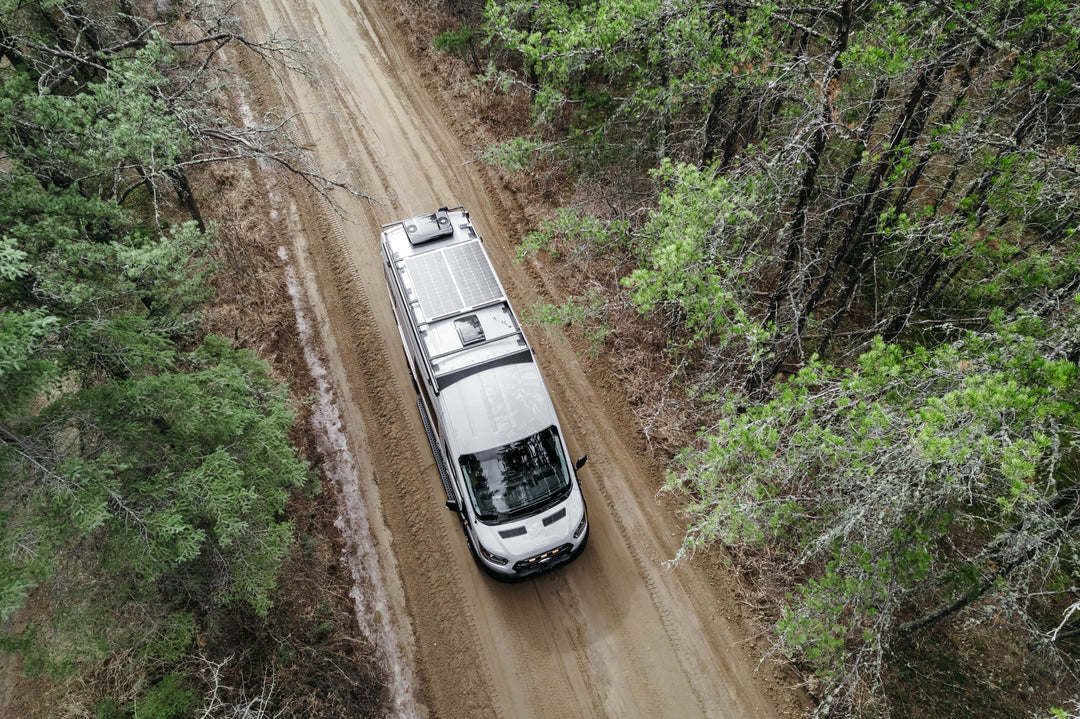


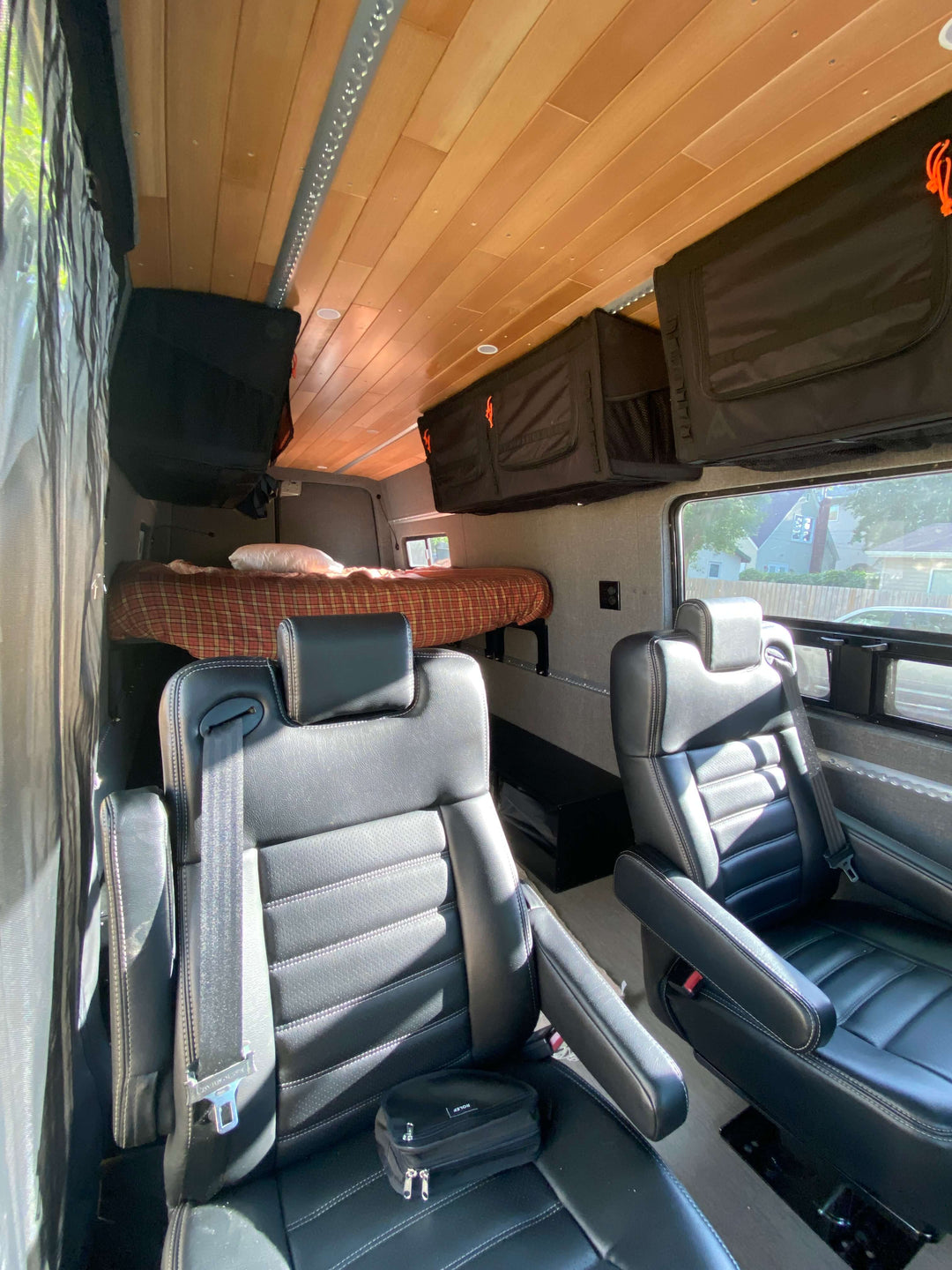
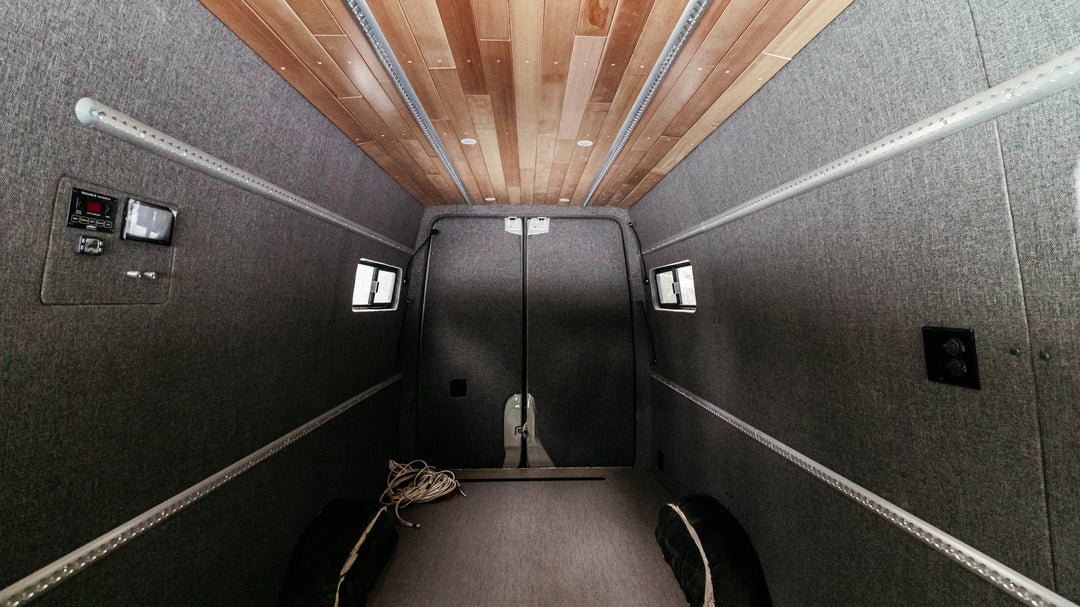
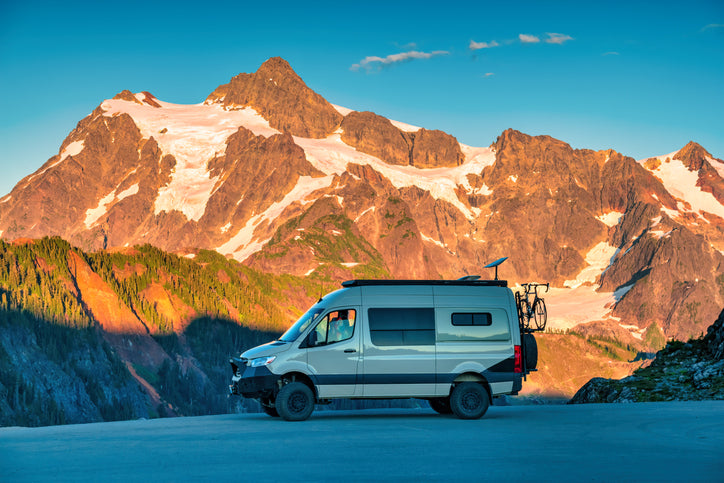
This is a great article. I would love more information on which older vans would be best to choose. My budget is tight, and I need a van that’s easy to drive and park, will keep me safe on and off the road, and not cost $50,000. Thank you.
This is the absolute best article covering everything about the van options and comparisons. Thank you!
Thanks for these great tips, I will be sure to check some more details to do this great project. Actually, I began showing interest in buying a van and turning it into a campervan when we have a family vacation in vegas last summer. We rent on the best las vegas van rentals and our family trip is so easy, the van was so spacious and clean so I can’t help imagining owning one and turning it into a campervan and touring around different states. This is so great, thanks again!
I would like to convert a long wheel base Chevy or GMC and ad a fiberglass raised roof. Do you have any articles on either of these conversations. Your assistance will be greatly appreciated.
Aloha Billy
Big Island Hawaii
808-747-6131
Just what I was looking for. Started my project. Will get serious and decide in late quarter of 2023. Thank you.
Leave a comment